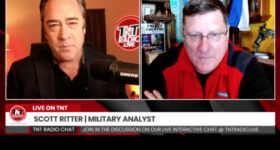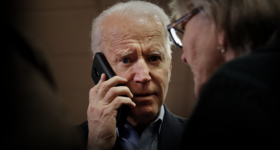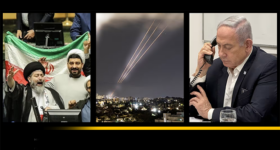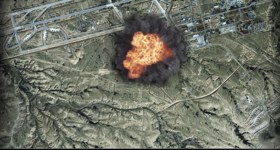21st Century Wire says…

PHOTO: graffiti against the U.S. military base is painted on a wall where a gas station used to stand across from the U.S. Air Force Kadena air base in Kadena, Okinawa, southwestern Japan.
World War II began in 1941 with Japan’s attack on Pearl Harbor. For 70 years, Japanese people on the island of Okinawa have been under military occupation from the United States – hosting one of America’s key Cold War overseas bases, but all that is finally coming to an end.
Plans are being drawn up now to relocate thousands of US troops off the island and over to other sites like Guam and Northern Mariana Islands, but the US cannot afford the whole cost involved. Eager to get the move underway, Japan has thrown in a $3.1 billion bailout for the Pentagon to fast-track the job. Some say it’s Washington’s final swipe at collecting war reparations from the country it devastated during the war.
 According to local reports from Okinawa residents and businesses (photo, left), aside from noisy new Osprey aircraft and aircraft vibration damage to local buildings, other problems from US military have persisted – alcohol abuse, bar fights, prostitution – and rape, have all been a source of tension on the island ever since America moved in. Residents are keen to see a return to normality in the community.
According to local reports from Okinawa residents and businesses (photo, left), aside from noisy new Osprey aircraft and aircraft vibration damage to local buildings, other problems from US military have persisted – alcohol abuse, bar fights, prostitution – and rape, have all been a source of tension on the island ever since America moved in. Residents are keen to see a return to normality in the community.
A 1995 rape of a Japanese schoolgirl by two Marines and a sailor triggered rage across the island, whose population is about 1.4 million. Another rape in 2012, along with other misdeeds by U.S. servicemen triggered new waves of anger.
US forces will be replaced by a fleet of long-range Global Hawk drones to be based at the airport. The total operation will cost $8.6 billion.
One has to ask the question then: is drone expansion is more important than repairing nuclear reactors currently pumping radiation into the environment at Fukushima?
Or is this the real reason why the US is wanting to pull out in the first place?
RT reports…
.
Japan to pay $3.1bn to remove US troops from Okinawa, will host spy drones
.
Tokyo is to foot a $3.1 billion bill, which is part of the cost for relocating American troops from Okinawa. For the first time, it will also host US long-range surveillance drones, which would help to monitor disputed islands in the East China Sea.
The cost-sharing agreement for the troop transfer and the future deployment of drones by next spring are both part of an effort aimed at updating the US-Japan military and diplomatic alliance.
The pledge to modernize the alliance for the first time in 16 years was made in a joint declaration during the visit of US Secretary of State John Kerry and US Defense Secretary Chuck Hagel, who met their Japanese counterparts, Foreign Minister Fumio Kishida and Defense Minister Itsunori Onodera.
Japan hosts some 50,000 American soldiers and officers, particularly in Okinawa. Their presence is a constant source of tension with local populations due to crimes committed by the servicemen, disruptions caused by military flights and land use by the US military.
Last year the countries announced a plan to relocate about 9,000 US Marines from Okinawa to other locations. 5,000 of them will go to Guam while others will be stationed elsewhere. The estimated cost of the relocation is about $8.6 billion.

A file picture taken on April 24, 2010 shows planes and helicopters stationed at the US Marine Corps Air Station Futenma base in Ginowan, Okinawa prefecture. (AFP Photo)
Japan will cover $3.1 billion of that sum, the officials from the two countries announced on Thursday. The cost includes development of new facilities in Guam and the Northern Mariana Islands.
As the foot soldiers leave, US Global Hawk unmanned aircraft will be arriving, marking the first time that American drones will be stationed on Japanese soil on a permanent basis. Two or three long-range spy drones will be placed at a US base to help monitor Japan’s territory.
While the disputed Senkaku Islands in the East China Sea was not mentioned in the documents, the islands contested by Japan, China and Taiwan was a prevailing topic in public speeches after the signing.
Hagel said the US reiterated that it recognizes Japan’s administration of the islands and has responsibilities to protect Japanese territory under a mutual defense treaty.
“We strongly oppose any unilateral or coercive action that seeks to undermine Japan’s administrative control,” he said.
The US will also deploy second X-band early warning radar in Japan. Officials were careful to stress that it will be directed against North Korea rather than China, and will help track down and probably intercept missiles coming from the defiant state. The plan to deploy radar was first announced by the then-Defense Secretary Leon Panetta about a year ago. The new system will be placed at Kyogamisaki air base in Kyoto prefecture in western Japan to complement already existing radar in the northern part of Japan.

This March 22, 2013 handout image provided by the US Navy shows the Sea-based, X-band Radar (SBX 1) transits the waters of Joint Base Pearl Harbor-Hickam in Pearl Harbor, Hawaii. (AFP Photo/US Navy)
Beijing however may not be convinced by the assurances. It has criticized the installation of the inaugural military radar, saying it could disrupt the strategic military balance in the region and destabilize the situation.
Other plans to boost US military presence in Japan include possible deployment of F-35 jet fighters around 2017, a top UN official told AP. There is also a plan to send Navy P-8 anti-submarine aircraft later this year – the first time the sub-killers deployment outside of US.
The upgrade also expands cooperation in areas like counter-terrorism and cyber warfare. The Internet threat is the one that Japan sometimes cannot defend itself against with the systems it currently has, Kazunori Kimura, the Defense Ministry’s director of cyber-defense planning, told Reuters.
–















